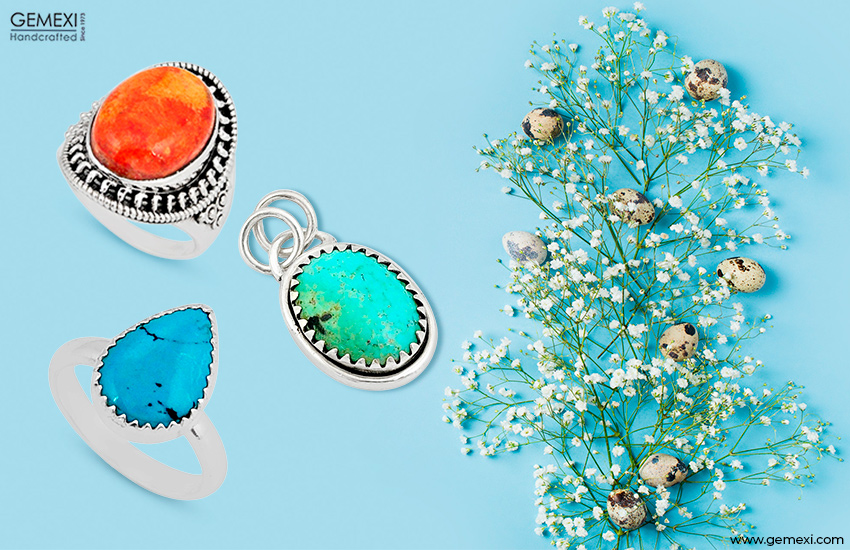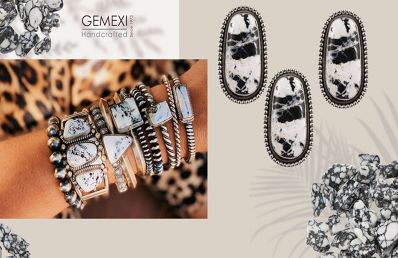What Does Turquoise Mean When Someone Wears Turquoise?
By Gemexi Team | Gemstone Healing- Updated On Nov 3, 2023

Wearing Turquoise: The Multifaceted Symbolism of a Timeless Gem Turquoise, with its captivating blue-green hue, has been cherished as a precious gemstone and symbol for centuries across various cultures. The meanings and significance of wearing turquoise jewelry or clothing are diverse and multifaceted, deeply rooted in history, spirituality, and personal beliefs. In this exploration, we delve into the rich tapestry of meanings that turquoise carries for those who adorn themselves with this stunning gem.
A Stone of Protection and Amulets:
Across many Native American cultures, turquoise is considered a potent protective stone. It is believed to guard the wearer against negative energies, evil spirits, and physical dangers. The turquoise gem often finds its way into amulets, talismans, and jewelry, serving as a symbolic shield against malevolent forces. The protective qualities attributed to turquoise stem from its vibrant color and the belief that it can absorb and deflect negative energies, ensuring the wearer's well-being and safety.
Healing and Well-Being:
Turquoise holds a special place in various holistic and spiritual practices. It is associated with healing, both physical and spiritual. In many belief systems, wearing turquoise is thought to have a positive impact on one's health and overall well-being. The stone is believed to promote rejuvenation, vitality, and a sense of renewal. Its calming and soothing properties make it a sought-after gem for those seeking physical and emotional healing. Wearing turquoise jewelry is thought to facilitate the flow of energy and promote balance within the body.
Communication and Self-Expression:
The vibrant and striking color of turquoise has long been associated with communication and self-expression. Wearing turquoise jewelry or clothing can symbolize an individual's desire to express themselves effectively and be heard. It encourages open and honest communication, allowing one's thoughts and creativity to flow freely. The gem is believed to facilitate self-expression and encourage the sharing of ideas, making it a popular choice for individuals who wish to convey their thoughts and feelings.
Spiritual and Emotional Balance:
Turquoise is often seen as a symbol of balance and harmony. It is thought to align the mind, body, and spirit, creating a sense of equilibrium and inner peace. The gem's soothing properties are believed to calm turbulent emotions and promote emotional stability. Wearing turquoise can be a way to seek spiritual and emotional balance in one's life and maintain a sense of inner calm.
Connection to Nature:
The natural beauty of turquoise, with its striking resemblance to the colors of the earth and sea, symbolizes a deep connection to nature. Wearing turquoise jewelry is often associated with a love for the natural world. It can represent an individual's appreciation for the environment and a desire to protect and preserve it. Turquoise, in this context, serves as a reminder of the beauty and importance of the natural world and the need to nurture it.
Fashion and Style:
Beyond its symbolic meanings, turquoise is a popular choice for jewelry and clothing due to its aesthetic appeal. The striking blue-green color adds a touch of elegance and uniqueness to any outfit. Whether it's a turquoise necklace, bracelet, or a piece of clothing, it can serve as a fashion statement. People wear turquoise not only for its symbolism but also for the sheer joy of incorporating its vibrant color into their personal style.
Cultural Significance:
Turquoise also holds cultural significance in various regions. For example, it has been highly valued in the Southwest United States, particularly among Native American tribes such as the Navajo and Zuni. In this context, turquoise is more than a fashion statement; it's a cultural emblem that reflects heritage and identity. In the Middle East, turquoise has a long history of being used in jewelry and as a symbol of protection, often referred to as "Feroza" in Persian culture.
Historical Perspective:
Throughout history, turquoise has been treasured by civilizations, from the ancient Egyptians to the Aztecs and the Persians. It was often used to create elaborate jewelry and intricate artifacts. The ancient Egyptians believed that turquoise symbolized rebirth, and it was often used in burial items to ensure safe passage to the afterlife. In the Americas, turquoise has adorned the tombs and ornaments of indigenous peoples for centuries. These historical uses reinforce the enduring significance of this gemstone.
Modern Interpretations:
In today's world, individuals wear turquoise for a myriad of reasons. It's often chosen as a personal reflection of one's beliefs and values. Whether as a symbol of protection, a conduit for self-expression, a fashion accessory, or a reminder of nature's beauty, turquoise offers a versatile canvas for people to convey their sentiments and style.
Birthstone and Zodiac Associations:
Turquoise is considered the birthstone for December and is linked to the zodiac signs of Sagittarius and Capricorn. People born under these signs are believed to particularly benefit from the positive attributes of turquoise, such as protection, healing, and communication.
Care and Preservation:
While turquoise is resilient, it is porous and can be susceptible to damage from exposure to moisture and chemicals. To ensure its longevity and maintain its vibrant color, proper care is essential. Avoid exposing turquoise jewelry to harsh chemicals, excessive sunlight, and moisture. Regular cleaning with a soft, damp cloth is recommended.
Conclusion:
Turquoise is a gemstone with a rich tapestry of meanings and interpretations that span across cultures, history, and individual beliefs. Whether worn for its protective properties, healing qualities, or as a fashion statement, turquoise remains a symbol of enduring significance. It is a testament to the power of jewelry and clothing in conveying personal values and sentiments, making it not just a beautiful accessory but a meaningful expression of the self.
- Tags:
- Turquoise Jewelry
- Wearing Turquoise Jewelry
- Turquoise Mean
- Wears Turquoise
- Native American Cultures
- Color Of Turquoise
- Beauty Of Turquoise










0 Comments
Write Comments